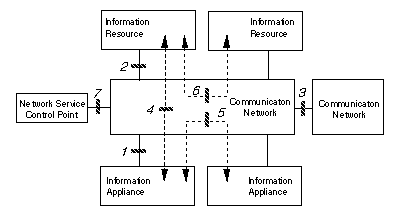

| Document Notes: |
| This document is extracted from a web document: "An Architectural Framework for the National Information Infrastructure". It was modified to reflect the organization and may have been restructured to fit the look and feel of the website. |
A reference architecture model describes a system in terms of the interconnection of basic functional elements and the interfaces between them. It clarifies where protocols must be defined and identifies groupings of functionality. It does not imply a physical implementation. A model of a Reference Architecture for the ITA is shown in the figure below.
ITA Architecture: Reference Model
The ITA Architecture Reference model identifies the following functional elements.
Appliances
Information appliances are the equipment by which an end user employs the ITA. These typically have input and display capabilities for communication with other users or service providers, processing capabilities, and interfaces to communications networks and services. Information appliances could be single-purpose or multipurpose devices structured as a platform for supporting various applications. Current examples include computers, cameras, pagers, scanners, keyboards, telephones, televisions and set-top boxes, fax machines, and remote sensors.
Networks
Networks typically consist of transmission facilities, routers, switches, multiplexers, protocol conversion equipment, interworking units, and directories. Examples of communications networks are broadcast radio and television, cable television distribution systems, public telecommunications networks, wireless data networks, value-added networks, and private corporate networks. These networks are intermediate systems employed by users and application and service providers.
Resources
Information resources i.e., the content, are the "guts" and the goal of the ITA. Examples are electronic bulletin boards, airline reservation systems, electronic mail systems, on-line financial transaction systems, digital libraries of film and literature, archives of entertainment material, national and local directory and listing information (e.g., white and yellow page phone books), and electronic transaction frameworks for business and industry databases. Information resources are provided by organizations and individuals who wish to provide services on the ITA.
Control points
Network service control points contain the means for managing networked elements of all kinds, including the physical infrastructure, services, and applications that use them. Network or service providers (or others) could choose to offer these control points, thereby providing a highly distributed set of mechanisms to manage the underlying capabilities of an open communications network and the use of other ITA enabling services. These management mechanisms will provide advanced capabilities such as custom addressing or routing, updating links to mobile or relocated destinations or resources, and the integration and management of diverse applications and services.
Interfaces between the elements of the ITA's component layers must be well-defined so that information can efficiently move across and make use of capabilities located in each layer. There should be open specifications at least for some critical set of interfaces and protocols to facilitate competition and entry and promote interoperability. Thus, the boundaries between the layers must be permeable in this high-level conceptual rendering. For example, end-user applications (which may be marketed as a service to customers) can be built from combinations of enabling services, and may employ specific physical devices. Similarly, specialized applications may evolve, by broad adoption, into enabling services. Moreover, where the function of interfaces can be provided effectively in an integrated way by equipment operated by a given service provider or user, the methods and interfaces it employs do not need to be open or standardized.
The following interfaces and protocols will exist in the ITA in multiple instances and open, well-defined specifications should be developed for them.
It may be possible for information appliances and information resources to use the same interface to communications networks. This could allow individual users to take on the role of information providers. However, a relatively simpler communications-network-to-information-processing-device interface may be more cost effective.
A well-defined application-to-platform interface in information appliances could facilitate the development of applications that partly exist in an information resource and partly in an information appliance. Application programming interfaces are examples of such interfaces.
While the Reference Architecture defines points at which interfaces and protocols will be defined, this is not to imply that they will be uniquely defined at each point. To meet the varying needs of different users, service providers, applications, and domains, a large and evolving set of interfaces and protocols will need to be created. To achieve a true National Information Infrastructure, interoperability and compatibility must be preserved. In addition to these interfaces and protocols, it will be important to define objects (documents, contracts, tokens, etc.) that are exchanged within the ITA and the interexchange formats in which these objects are coded for exchange. Other objectives that should drive the specification of ITA interfaces, protocols, and objects include the following: